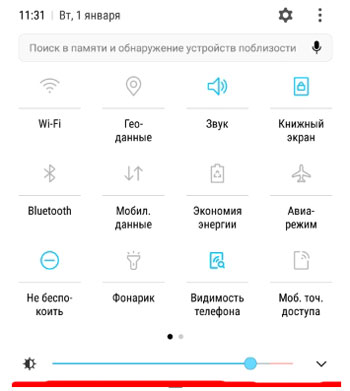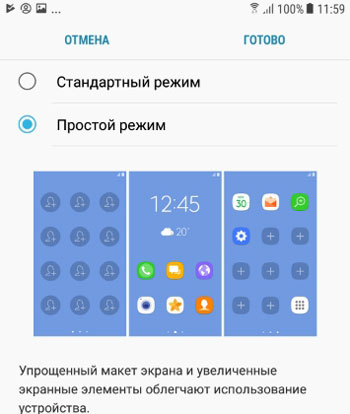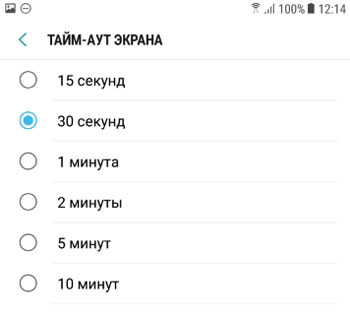 How do I set display brightness and set automatic brightness? How do I increase the font and scale of the screen? How do I choose the home screen and timeout time (when the screen goes blank)? Change the splash screen and icon frames. Read about everything about this and other display settings in this article.
How do I set display brightness and set automatic brightness? How do I increase the font and scale of the screen? How do I choose the home screen and timeout time (when the screen goes blank)? Change the splash screen and icon frames. Read about everything about this and other display settings in this article.
Display brightness
Setting the display brightness is easy. This can be done in two ways.
Method 1. We make a swipe from top to bottom from the top edge of the screen – a quick access menu will appear, we also make a swipe. Set the desired brightness at the bottom.

Method 2. Go to Settings – Display. Other screen settings are also available here – more about them later.
to the content
Automatic brightness
Automatic adjustment of the screen brightness often helps: on the street in the sun it rises, in a dark room – the brightness is at a minimum. How to setup?
Method 1. Through the quick access menu. We make a double swipe to call up the menu on the screen, click on the checkmark next to the brightness setting – an additional will open. menu:

Method 2. Go to Settings – Display and put the switch to “On”.

to the content
Screen mode
You can change the color gamut optimization, color saturation, and display sharpness. There are 4 installation options available:
- Responsive display – all color settings are set automatically. I recommend setting this setting.
- Movie AMOLED – the mode is suitable for watching video. AMOLED is the name of the technology by which the smartphone screen is made.
- Photo AMOLED – for viewing photos and any images.
- Main.
Go to Settings – Display – Screen Mode.

to the content
Screen and font scale
How do I zoom in / out the screen? change font size and style? Go to Settings – Display – Screen and Font Scale.

By changing the scale of the screen, you will see the changes above for the example of SMS messages. For the visually impaired, the elderly, I recommend setting the maximum font size. Accordingly, the smaller the font size, the more information fits on the screen.
To change the font style, use the settings below. There are 5 preinstalled fonts available: basic, gothic, choko cooky, Cool jazz, Rosemary.

You can always download additional fonts from the Samsung Appls, both paid and free. More than 100 different fonts are available in the Market.
to the content
Main screen
You can set the home screen that will be displayed when the phone is booted up in Settings – Display – Home screen.

Here is a screen layout. Additionally, you can customize the wallpaper, add widgets and select the screen grid (4 × 4, 4 × 5, 5 × 5 – i.e. choose how many icons vertically and horizontally will fit on the screen).
to the content
Simple Mode
The simple display mode is more suitable for older people who poorly see small icons and inscriptions, and also find it difficult to use a smartphone.
To set Simple Mode, go to Settings – Display – Simple Mode.

After activating the mode, the font and screen scale will automatically increase, the menu will be simplified.
to the content
Icon frames
This option adds borders (background) to icons on the screen. This is expected to make the icons stand out on the Home screen and Apps screens. In fact, it doesn't look very pretty. Better not to use.
To enable icon frames, go to Settings – Display – Icon frames.

to the content
Status bar
The status bar is what you see at the very top of the screen. These are notification icons, time, battery power, Wi-Fi and bluetooth icons (if enabled), the cellular network icon.

Go to Settings – Display – Status bar. There are 2 options available here:
- Show only recent notifications (3 icons). Allows you not to litter the string, so as not to get confused yourself. To remove notification icons, simply delete the notifications themselves through the quick access menu (swipe down from the top of the screen and “Clear all”).
- Show charging percentage is a very useful feature.
to the content
Screen timeout
A very useful option that will add convenience to using your smartphone and conserve battery power if you forget to turn off the display. Those. this is the time after which the screen turns off and locks. The following options are available (period of inactivity):
- 15 seconds,
- 30 seconds,
- 1 minute,
- 2 minutes,
- 5 minutes,
- 10 minutes.
Go to Settings – Display – Screen Timeout.

I recommend setting 30 seconds – that's quite enough. If there is no activity during this time, the display will turn off.
to the content
Do not turn on the screen
The option prevents accidental activation of the phone screen in a dark place, for example, in a pocket or bag. This will save you battery power. I recommend enabling (Settings – Display – Do not turn on the screen).

to the content
Screen saver
The choice of screen saver is purely individual. How do I set it up? Let's go to Settings – Display – Screensaver.

There are 4 installation options available: change colors, Google photos, photo frame (photos change each other) and photo wall (several photos are collected on one screen). You can choose the built-in wallpaper in the phone, screenshots of the screen, your photos and sent by WhatsApp.
By choosing the desired option, you can always see a preview and choose the time of use (when installed on the stand, when charging, or both). Click on the 3 vertical dots in the upper right corner.

These are all the basic display settings on Samsung smartphones. You will find similar settings on phones of other brands on Android.
